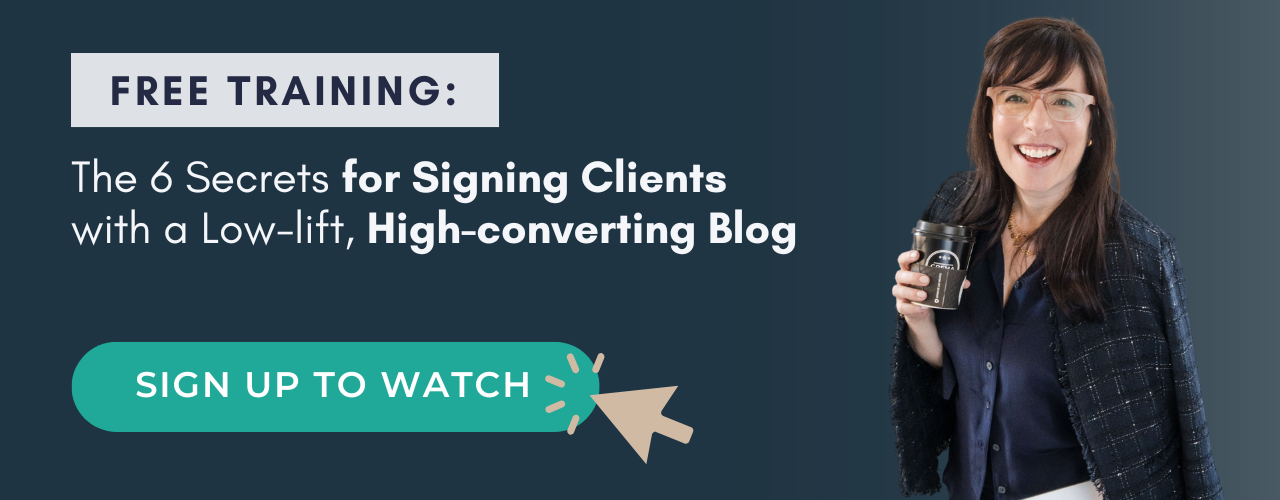If you’ve ever started to write a blog post — but then started second-guessing what the call-to-action (CTA) at the end should be — you’re not alone.
Thoughts bubble up like…
💭 Should I link to my freebie?
💭 Should I tell them to book a discovery call?
💭 What if they’re not ready to buy yet?
💭 What if I push too hard and turn them off?
This unsureness can keep you stuck.
If you’re anything like most of the coaches and service providers I work with, you’re trying to make sure your blog content not only teaches, but leads somewhere. You want it to convert. You want it to matter…
So where should it lead?
And that’s exactly what this post is about: helping you make clear, strategic decisions about your blog post CTAs — without second-guessing every step.
Let’s break it down:
Coaches + service providers have CTA options — but they should all roll up to the same paid offer.
When I teach students inside High-leverage Content how to create a capsule blog library that leads to clients, we center the entire content strategy around one specific offer.
That’s your North Star.
Every post you write in one capsule library should help your reader get one step closer to being ready to buy that one offer — whether it happens today, next week, or six months from now.
But that doesn’t mean every single blog post needs to have the same CTA.
You’re not limited to one call to action across the board. In fact, you can vary your CTAs — as long as they all still support the same core offer.
Some posts will naturally point directly to your paid program (the next step in your sales process is — like booking a call, applying, or clicking to a sales page).
Others will point to your email list — usually through a freebie or lead magnet.
In all cases, the CTA should be aligned with the offer your blog library is designed to support. That’s the key.
So now that you know you have those options… How do you decide which? Let’s cover it next…
Blog CTAs for coaches + service providers: Paid offer or lead magnet? How to Decide:
So some blog posts can offer the next step in your sales process, and others offer an opportunity to jump onto your email list.
Let’s look at how to decide which, for each post.
We’ll break it down into two scenarios:
✅ Scenario 1: You don’t have a tested lead magnet, yet.
It’s totally okay if you have a new(ish) offer and haven’t quiiiiiite landed on a lead magnet idea that you really like yet. Or maybe you’re testing a new lead magnet, and you want to see how it converts before you add it as a CTA to a bunch of your blog posts.
No problem. Totally normal.
And you don’t *need* a lead magnet to start creating client-converting blog content.
(In fact, the way I teach you to write your blog post content — focusing on what your audience needs to hear and understand more deeply in order to be ready to work with you — often becomes the foundation for a future lead magnet. It literally helps you come up with the lead magnet topic and content!)
So if you don’t have one yet, don’t stress… Just point people to the next step in your sales process. That could be booking a discovery call, applying to work with you, or clicking to your sales page.
For a long time, that’s what I did with my blog posts that sell High-leverage Content.
For nearly two years, I didn’t have a freebie I really loved yet. I didn’t want to slap a random one on there just to have one. So all of my blog post CTAs pointed straight to the offer — and it still worked.
Later, once I had a lead magnet I liked (my free on-demand training), I swapped that CTA into a few posts where it made sense. You can do the same.
Just make sure your lead magnet is aligned with the paid offer your blog library is designed to support. Don’t use a random freebie just because it exists. You want something that builds demand for your offer — not something that leads people sideways.
(Example: My offers focused on Pinterest Strategy for years, before I pivoted a little and started my High-leverage Content blog writing program. So I have lots of Pinterest freebies floating around. But I would not use those as the CTA for a blog post that is about blog writing. Even though they are tangentially related, that freebie wouldn’t be closely enough aligned with the paid offer I’m writing about.)
✅ Scenario 2: You *do* have a tested lead magnet ready to go.
In this case, you have two options:
Option 1 is to use your lead magnet as the CTA in all of your blog posts. I will say… this isn’t my favorite option. (More on why in a few minutes…)
I would usually rather have you go with…
Option 2, which is to use a CTA to your paid offer in some of your blog posts, and to use your lead magnet as the main CTA in some of your posts.
So how to decide which ones are which?
Here’s a rule of thumb I teach inside HLC that takes the guesswork out of this:
If the blog post is for people who are just starting to learn about you and the work you do — a lead magnet CTA usually makes the most sense.
These folks are often what marketers call “top of funnel” leads — or you may have heard the term “cold” leads… same basic idea!
Your reader is likely aware of the problem but may not be considering your offer yet. So your freebie can be an easy, low-pressure next step that keeps them in your world and builds trust.
On the other hand, if the blog post is more conversion-focused — meaning you’re sharing your framework, telling a story about a client result, answering questions people ask before they buy, or addressing common objections — then it usually makes more sense to go ahead and pitch your offer… Because think about it: If someone’s reading that kind of post, they’re probably already considering working with you. Don’t make them hunt for the next step!
Is this a hard-and-fast rule? Of course not. But it’s a helpful guide that works really well when you’re deciding what CTA to use in each post — especially when you’re just getting your capsule blog library off the ground.
A Real-Life Example from My Blog CTAs:
I once wrote a post called “How to Start a Coaching Blog that Fills Your Client Roster.” It was all about the steps that any coach who is “blog curious” should plan to take, if they want to start a blog that will give them good ROI on the time they put into it.
Since I wrote it for the business owner who is just starting to learn about me and my approaches to blog writing…
I’ll soon be switching that post’s CTA from “join HLC” to “sign up for my free blog training.”
(Again, the reason it’s still “join HLC” at the the time I’m writing this is because up until recently, I didn’t have a tested lead magnet for this offer yet.)
Meanwhile, in another post I wrote, “The ‘Unforced SEO’ Blog Strategy That Got Me Booked Out With Clients,” I’m busting up an objection that my students-to-be sometimes have about blogging: They don’t want to have to learn SEO; it feels hard and they don’t want to have to write for keywords.
Since this post answers a common objection, it’s really more for people who are already thinking about joining my offer, and they just need this barrier removed…
So once I remove it, I want them to have the “buy” button handy, right? They are ready. They don’t need my lead magnet (or any more convincing!). They need HLC! 🙂 — so it made sense that the CTA is to go directly to the sales page.
A Caveat: Don’t Default to the Freebie CTA, Just to Play It Safe
Now… Remember above when I said that, if you have a lead magnet, you could choose “Option 1” and use your lead magnet as the CTA in all of your blog posts?
Here’s the caveat on that.
Sometimes I see a service provider or a coach who only want to link to their lead magnet in blog posts — because they’re afraid to pitch their paid offer.
Sometimes it’s coming from a genuine desire to nurture — but more often, it’s coming from fear. Fear of seeming “too salesy.” Fear of pushing people away.
But here’s the thing: not everyone needs to be nurtured for months before they’re ready to hire you. Especially when your content is written the way I teach inside HLC — strategically, intentionally, and with the goal of building desire and clarity.
When you write High-leverage Content, some people will feel ready fast. Give them that path. Don’t hide your offer.
Make sure you’re choosing your CTA for strategic reasons — not because you’re nervous about selling!
Also: Don’t Overthink Your Blog’s CTAs!
This is important.
You won’t always know exactly where a reader is in their “journey” when they land on your blog. You don’t know how well they know you, your approaches, or your offers.
They could be coming from your email list… because they found your business card at the gym… from a social share… referred from a current clients… from a podcast you were on… or even a Google search. (Just to name a few!)
You can’t control when they find your blog post.
(Evergreen blog content is just that — evergreen! By design!)
So I do not want you stressing too much about whether your blog CTA should be your lead magnet, or the next step in your paid offer sales process. I don’t want you trying to plan for every circumstance or every blog reader’s stage of “readiness.”
I want you to simply write a strong, focused blog post — and then choose one clear, logical call to action that fits the tone and intent of that post.
And when you’re not sure?
Step into your future client’s shoes.
Ask yourself: Once they’ve read this… what would be most helpful to them next?
That’s usually your answer.
Want More Blog Strategy Like This?
I go deeper into how to create client-attracting blog content inside my free training:
👉 The 6 Secrets to Signing Clients — Without the Content Treadmill
with a Low-Lift, High-Converting Blog
If you’re a coach or service provider who wants a simpler, smarter way to show up online and build demand for your offers — this is for you. Sign up here to get instant access to the training!



